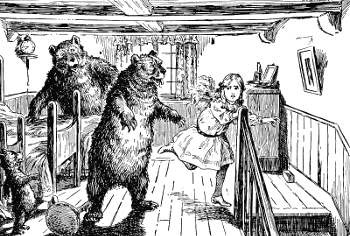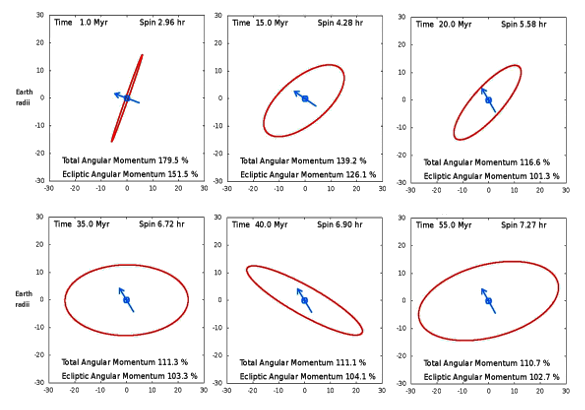Lunar Origin
November 28, 2016
Just two
decades ago, no
planets were known outside our
Solar System. In 1995, the
exoplanet,
51 Pegasi b was found in orbit about its host
star,
51 Pegasi. At this writing, there are
more than 3300 confirmed exoplanets existing in about 1200
planetary systems. Advancing
observational technologies will reveal many more exoplanets in the future.
Many such exoplanets resemble planets in our own Solar System, but only one of these planets is known to harbor
living organisms.
Earth exists in the
Goldilocks zone of our
Sun, more technically called the Sun's
circumstellar habitable zone. In this zone, the conditions for the
origin and
evolution of life are "just right."
What was surprising to me was that the original "
Three Bears" story didn't feature a
little girl, but an
old woman who "could not have been a good,
honest old Woman," since she entered the Bear's house without permission. She was also
reviled for her
profanity.
"So first she tasted the porridge of the Great, Huge Bear, and that was too hot for her; and she said a bad word about that. And then she tasted the porridge of the Middle Bear, and that was too cold for her; and she said a bad word about that too. And then she went to the porridge of the Little, Small, Wee Bear, and tasted that; and that was neither too hot nor too cold, but just right; and she liked it so well that she ate it all up."[1]

Goldilocks running from the three bears in the Three Bears story that I remember.
(From The Book of Knowledge, Arthur Mee and Holland Thompson, eds., The Grolier Society (New York, 1912) via Wikimedia Commons.)
This "just right" condition for a planet is an
orbit about its host star that would allow the presence of
liquid water on its surface, provided that other
environmental requirements, such as an
atmosphere to contain the water, are present. Life, as we know it, needs water, but was this the only important factor for the
genesis of life on Earth?
The Earth is unique among the planets in having a huge, solitary
Moon, and such
moons are likely rare elsewhere in the galaxy. It's
conjectured that the presence of the Moon may have been important to the genesis and evolution of life on Earth. I reviewed one particular influence of the Moon on the Earth, the
lunar tides, in a previous article (Synchronizing to the Moon, April 11, 2016).
The lunar tides would have been a mechanism for
concentrating ocean chemicals in littoral ponds as a way to generate early proto-biotic molecules such as the
polymer precursors to
nucleic acids. The tides would have aided
thermal equilibration of our planet to smooth
climate fluctuations.[2]

Is this any way to treat a neighbor?
(Still image from Georges Méliès' 1902 film, "Le Voyage dans la lune" (A Trip to the Moon), colorized Wikimedia Commons image.)
However, the Moon acted to create a stable environment for life long before the creation of Earth's
oceans by stabilizing its
axis of rotation and establishing the
tilt to the orbital plane (its obliquity) that's responsible for our mild
seasonal variation. An early
analysis of the Earth's obliquity without the presence of the Moon showed that our axial tilt would have
chaotically shifted between 0
degrees and about 85 degrees. The
torque exerted on the Earth by the Moon keeps our axial tilt at 23.3° ±1.3° and acts as a climate regulator.[3]
Astronomers have attempted to
extrapolate the
dynamics of the Earth-Moon system backwards in time to discover the origin of our unique planetary system. The
giant-impact hypothesis, that the Earth-Moon system formed from a
coalescence of the
matter left after a
collision of an early Earth with another planet, is the preferred
theory, since it explains so many things. The giant-impact hypothesis explains why the Moon has an
iron core, its surface was once
molten, and Earth rocks and Moon rocks seem to have had a common origin.
One thing that's not explained by the giant-impact hypothesis is why the Moon's orbit is tilted five degrees from the
ecliptic, which is the
plane of Earth's orbit around the Sun. A new study by astronomers at the
SETI Institute (Mountain View, California), the
University of Maryland (College Park, Maryland),
Harvard University (Cambridge, Massachusetts), and the
University of California, Davis, (Davis, California) presents evidence that a more energetic collision of the
proto-Earth with the planet-sized body, called
Theia, would explain the present features of the Earth-Moon system.[4-5]
The energetic impact
model starts at the same place as previous models, with the planetary impact, but the impact was so energetic that the planetary bodies were both reduced to a cloud of
vapor and molten material. Both the Earth and Moon would have
condensed from this cloud, thus their similar compositions.[5]
Conservation of angular momentum is the fundamental principle that guides our understanding of planetary dynamics. According to the energetic impact model, some of the angular momentum of the Earth-Moon system was transferred to the Earth-Sun system.[4-5]

Evolution of the Earth/Moon system from 1-55 million years. After formation of the Earth-Moon system, Earth's axis points towards the Sun. Over the course of millions of years, the orbit of the Moon (red) becomes more distant, and Earth's day gets longer, while a transfer of angular momentum causes Earth's axis to tilt to its modern value. (Still images from a SETI Institute video by Matija Ćuk. Click for larger image.)
This transfer of angular momentum happened when the Moon's orbit enlarged to a point called the "
LaPlace plane transition." This is the point at which the
gravitational force caused by the Earth became less important than the gravitational force of the Sun.[5] This caused the Earth's axis to flip upwards from its orbital plane. Eventually, the Moon went from an orbit of high inclination to the ecliptic to its present 5 degree inclination.[5]
This energetic impact model explains the similarity in composition of the Earth and the Moon, while also reproducing its present orbit.[4-5] This
research was funded by
NASA.[5]
References:
- The Story of the Three Bears, Chapter 18 of "English Fairy Tales" by Joseph Jacobs, G. P. Putnam's Sons (New York, 1890).
- Bruce Dorminey, "Without the Moon, Would There Be Life on Earth?" Scientific American, April 21, 2009.
- J. Laskar, F. Joutel, and P. Robutel, "Stabilization of the Earth's obliquity by the Moon," Nature, vol. 361, no. 6413 (18 February 18, 1993), pp. 615-617, doi:10.1038/361615a0.
- Matija Ćuk, Douglas P. Hamilton, Simon J. Lock, and Sarah T. Stewart, "Tidal evolution of the Moon from a high-obliquity, high-angular-momentum Earth," Nature, Advanced Online Publication (October 31, 2016), doi:10.1038/nature19846.
- Andy Fell, "New Theory Explains How the Moon Got There," University of California Davis Press Release, October 31, 2016.
- Origins of Earth and Moon, Sarah Stewart's web site.
Permanent Link to this article
Linked Keywords: Decade; planet; Solar System; exoplanet; 51 Pegasi b; star; 51 Pegasi; list of exoplanets; planetary system; observational astronomy; technology; technologies; life; living organism; Earth; circumstellar habitable zone; Goldilocks zone; Sun; abiogenesis; origin of life; evolution; Goldilocks and the Three Bears; child; girl; adult; woman; honesty; honest; revile; profanity; taste; tasted; porridge; eating; ate; Goldilocks; bear; Three Bears story; Wikimedia Commons; orbit; liquid water; environment; environmental; atmosphere; genesis; Moon; natural satellite; moon; Milky Way; galaxy; conjecture; lunar tide; concentration; concentrating; ocean; chemical compound; littoral zone; pond; biology; proto-biotic; molecule; polymer; precursor; nucleic acid; thermal equilibrium; thermal equilibration; climate change; climate fluctuation; neighbourhood; neighbor; Georges Méliès; A Trip to the Moon; Le Voyage dans la lune; axis of rotation; axial tilt; tilt to the orbital plane; season; seasonal; analysis; chaos theory; chaotic; degree; torque; astronomer; extrapolation; extrapolate; dynamics; giant-impact hypothesis; coalescence; coalescence; matter; collision; theory; iron; planetary core; melting; molten; ecliptic; plane; SETI Institute (Mountain View, California); University of Maryland (College Park, Maryland); Harvard University (Cambridge, Massachusetts); University of California, Davis, (Davis, California); early Earth; proto-Earth; Theia; mathematical model; vapor; condensation; condense; conservation of angular momentum; orbit of the Moon; Matija Ćuk; Pierre-Simon Laplace; Newton's law of universal gravitation; gravitational force; research; NASA.